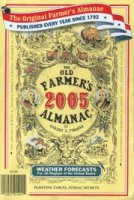Saturday
Jan142006
The Why vs. When of Weather
 Saturday, January 14, 2006
Saturday, January 14, 2006  It has been a relatively mild January in the Philadelphia area, with high temperatures significantly above the normal temperature range for this time of year. This type of occurrence is often thought to be a sign of global warming. This is not obvious - in fact there have been very large changes in January temperatures, both high and low, throughout the past century. (And January of 2005 was hotter than the current month!) This means that we cannot look at at our temperature record alone as a signature of global warming. This is true even if there is a string of higher-than-average-temperature days, months, or even years. Repeatability in weather patterns is certainly nothing one can count on.
It has been a relatively mild January in the Philadelphia area, with high temperatures significantly above the normal temperature range for this time of year. This type of occurrence is often thought to be a sign of global warming. This is not obvious - in fact there have been very large changes in January temperatures, both high and low, throughout the past century. (And January of 2005 was hotter than the current month!) This means that we cannot look at at our temperature record alone as a signature of global warming. This is true even if there is a string of higher-than-average-temperature days, months, or even years. Repeatability in weather patterns is certainly nothing one can count on.Edward Lorenz did show that a simplistic weather model based on three coupled non-linear differential equations produces weather patterns that never repeat. He used this fact, coupled with the sensitive dependence on initial conditions (SDIC) to make strong claims against the impossibility of accurate weather prediction. His model also predicted sudden swings in weather patterns - similar to what we are now experiencing.
Jim Laver, the director of the Climate Prediction Center is quoted in today's Inquirer, explaining why the weather has been warmer - it is due to easterly winds from the Pacific as opposed to cold Canadian air dominating our area this month. But why the shift in winds? There is this follow-up quote from Jim Poirer of the National Weather Service in Mount Holly, NJ: "If we knew why, we'd make money."
What's wrong with this statement?
According to Lorenz, we do know why - weather is a non-linear system that displays SDIC, and its phase-space trajectory is a strange attractor. It is the when that we don't know. This is a case where we do understand, but cannot predict with reasonable accuracy.


Reader Comments